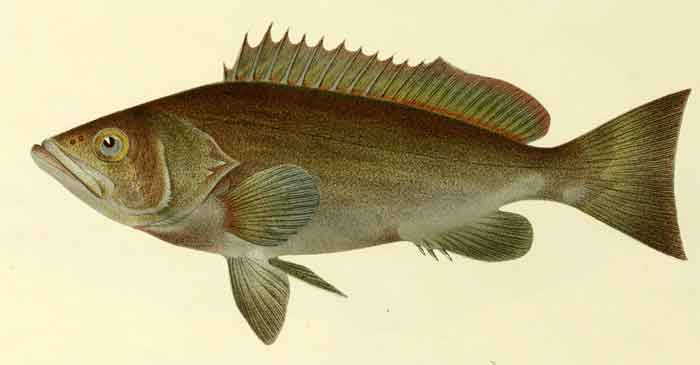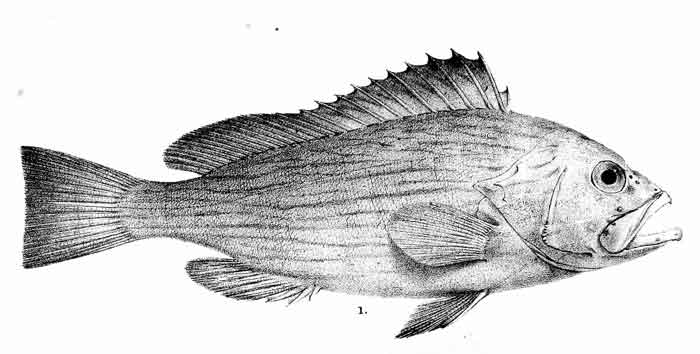Superregnum: Eukaryota
Cladus: Unikonta
Cladus: Opisthokonta
Cladus: Holozoa
Regnum: Animalia
Subregnum: Eumetazoa
Cladus: Bilateria
Cladus: Nephrozoa
Superphylum: Deuterostomia
Phylum: Chordata
Subphylum: Vertebrata
Infraphylum: Gnathostomata
Megaclassis: Osteichthyes
Superclassis/Classis: Actinopterygii
Classis/Subclassis: Actinopteri
Subclassis/Infraclassis: Neopterygii
Infraclassis: Teleostei
Megacohors: Osteoglossocephalai
Supercohors: Clupeocephala
Cohors: Euteleosteomorpha
Subcohors: Neoteleostei
Infracohors: Eurypterygia
Sectio: Ctenosquamata
Subsectio: Acanthomorphata
Divisio/Superordo: Acanthopterygii
Subdivisio: Percomorphaceae
Series: Eupercaria
Ordo: Perciformes
Subordo: Percoidei
Superfamilia: Percoidea
Familia: Serranidae
Subfamilia: Epinephelinae
Genus: Mycteroperca
Species: M. acutirostris – M. bonaci – M. cidi – M. fusca – M. interstitialis – M. jordani – M. microlepis – M. olfax – M. phenax – M. prionura – M. rosacea – M. rubra – M. tigris – M. venenosa – M. xenarcha
Name
Mycteroperca Gill, 1862

Mycteroperca acutirostris
References
Mycteroperca – Taxon details on Integrated Taxonomic Information System (ITIS).
Mycteroperca species list in FishBase,
Froese, R. & Pauly, D. (eds.) 2024. FishBase. World Wide Web electronic publication, www.fishbase.org, version 02/2024.
Vernacular names

Mycteroperca acutirostris
Mycteroperca is a genus of marine ray-finned fish, groupers from the subfamily Epinephelinae, part of the family Serranidae, which also includes the anthias and sea basses. They are predatory fish, largely associated with reefs and are found in tropical and subtropical seas in the Atlantic Ocean and the eastern Pacific Ocean. They are important target species for fisheries.
Characteristics
The fishes in the genus Mycteroperca have oblong bodies in which the depth of the body is less than the length of the head, which is a quarter to just under a third of the standard length. The length of the snout is noticeably longer than the diameter of the eye. The dorsal profile of the head is convex and the area between the eyes is also convex, having a width greater than the diameter of the eyes (in fish with a standard length greater than 20 centimetres (7.9 in)). The edges of the preopercle are serrated and the serrations at the bones angle may, or may not, be enlarged. The upper edge of gill cover is convex. The lower edge of upper jaw is straight near the joint and there is no knob, distinct step or hook present. The supramaxilla well developed. The lower jaw projects beyond the upper jaw and there are obvious canines in the front of both jaws while there are also teeth on roof of the mouth. In these fishes the dorsal fin contains 11 spines and 15 to 18 soft rays while the anal fin contains 3 spines and 10 to 13 soft rays, the central rays being longer than the others. The caudal fin may be truncate, emarginate or concave in shape and has 8 branched fin rays and 9 to 12 rays in its lower part which are placed further towards the margin. The scales along the flanks around the lateral line are ctenoid.[3]
Habitat and biology
Mycteroperca are found in coral reefs and over rocky bottoms at depths between 12 and 200 metres (39 and 656 ft) as adults while juveniles are found in shallower rock habitats, in sea grass beds and in estuarine environments. The adults are piscivorous, apart from the species in the rubra species complex which feed on zooplankton. The juveniles prey largely on crustaceans, although they will eat other invertebrates.[3]
Distribution
Mycteroperca groupers are mainly found in the eastern Pacific and western Atlantic Ocean with two species in the eastern Atlantic Ocean and the Mediterranean Sea.[3]
Utilisation
The groupers in the genus Mycteroperca are valuable target species for both recreational and commercial fisheries.[3]
Taxonomy
Mycteroperca was named as a genus by the American ichthyologist Theodore Nicholas Gill (1837–1914) with the type species being Serranus olfax. This genus appears to be more closely related to the genus Epinephelus than they are to the other relatively speciose genus in the tribe Epinephelini, Cephalopholis.[3]
Extant Species
It contains the following species:[4]
| Image | Scientific name | Common Name | Distribution |
|---|---|---|---|
| Mycteroperca acutirostris (Valenciennes, 1828) | Comb grouper, western comb grouper or wavy-lined grouper | western Atlantic Ocean. | |
 |
Mycteroperca bonaci (Poey, 1860) | Black grouper, black rockfish or marbled rockfish | western Atlantic where its range extends from Cape Canaveral in Florida and Bermuda south to the Bahamas, into the Gulf of Mexico as far north as Alabama and from southern Texas along the coast of Mexico and Cuba |
| Mycteroperca cidi Cervigón, 1966 | Venezuelan grouper | South America where its range extends from Santa Marta in Colombia to the Paria Peninsula in Venezuela | |
 |
Mycteroperca fusca Lowe, 1838 | Island grouper or comb grouper | the Canary Islands, Azores, Madeira and Cape Verde |
 |
Mycteroperca interstitialis (Poey, 1860) | Yellowmouth grouper | crossband rockfish, grey mannock, hamlet, harlequin rockfish, princess rockfish, rockfish, salmon grouper, salmon rock fish or scamp |
| Mycteroperca jordani (Jenkins & Evermann, 1889) | Gulf grouper | Mexican waters from San Carlos, Baja California Sur south to Mazatlán. It is found throughout the Gulf of California and around the Revillagigedos Islands. | |
 |
Mycteroperca microlepis (Goode & Bean, 1879) | Gag grouper, gag, velvet rockfish or charcoal belly | Atlantic Ocean Bermuda and along the eastern coast of the United States from North Carolina south to Yucatan Peninsula of Mexico |
 |
Mycteroperca olfax (Jenyns, 1840) | Sailfin grouper, bacalao grouper, colorado grouper or yellow grouper | Pacific Ocean where it occurs in the waters off the Galapagos Islands of Ecuador, Cocos Island in Costa Rica and Malpelo Island of Colombia. |
 |
Mycteroperca phenax Jordan & Swain, 1884 | Scamp | western Atlantic Ocean from North Carolina south along the southern Atlantic coast of the United States into the Gulf of Mexico |
 |
Mycteroperca prionura Rosenblatt & Zahuranec, 1967 | Sawtail grouper | western coasts of Mexico. |
 |
Mycteroperca rosacea (Streets, 1877) | Leopard grouper | Eastern Central Pacific |
 |
Mycteroperca rubra (Bloch, 1793) | Mottled grouper | eastern Atlantic Ocean and the Mediterranean Sea. |
 |
Mycteroperca tigris (Valenciennes, 1833) | Tiger grouper | western Atlantic Ocean from southeastern Florida, Bermuda and the Bahamas, as well as the Flower Garden Banks in the north, southwards through the Caribbean Sea to the Maroni River in French Guiana. |
 |
Mycteroperca venenosa (Linnaeus, 1758) | Yellowfin grouper | western Atlantic Ocean |
 |
Mycteroperca xenarcha Jordan, 1888 | Broomtail grouper or mangrove grouper | eastern Pacific along the western coast of the Americas from California to Peru. |
References
Eschmeyer, William N.; Fricke, Ron & van der Laan, Richard (eds.). "Mycteroperca". Catalog of Fishes. California Academy of Sciences. Retrieved 22 July 2020.
Eschmeyer, William N.; Fricke, Ron & van der Laan, Richard (eds.). "Genera in the family Epinephelinae". Catalog of Fishes. California Academy of Sciences. Retrieved 22 July 2020.
Heemstra, P.C. & J.E. Randall (1993). FAO Species Catalogue. Vol. 16. Groupers of the world (family Serranidae, subfamily Epinephelinae). An annotated and illustrated catalogue of the grouper, rockcod, hind, coral grouper and lyretail species known to date (PDF). FAO Fish. Synopsis. Vol. 125. FAO, Rome. pp. 256–257. ISBN 92-5-103125-8.
Froese, Rainer and Pauly, Daniel, eds. (2019). Mycteroperca Species of 'Mycteroperca' in FishBase. December 2019 version.
Retrieved from "http://en.wikipedia.org/"
All text is available under the terms of the GNU Free Documentation License

